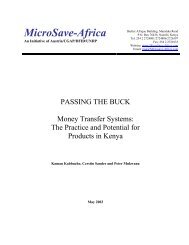Create successful ePaper yourself
Turn your PDF publications into a flip-book with our unique Google optimized e-Paper software.
Tony Barclay was<br />
active in giving a voice<br />
to development firms,<br />
working with the<br />
Center for U.S. Global<br />
Engagement and<br />
other groups.<br />
76<br />
A Voice for the Industry<br />
For its first 20 <strong>years</strong>, <strong>DAI</strong> had always coped,<br />
more or less on its own, with the ups and downs<br />
<strong>of</strong> American foreign aid funding and policy shifts<br />
as administrations came and went. It did not<br />
see itself as part <strong>of</strong> the political process, and<br />
thus it invested mainly in relationships with the<br />
technical staff in USAID who were its clients,<br />
and managers in overseas missions. Other contractors<br />
took the same approach. By contrast,<br />
the nongovernmental organizations (NGOs)<br />
had established their own umbrella group,<br />
InterAction, which was very active on Capitol<br />
Hill, lobbying for NGO interests and influencing<br />
decisions about where foreign aid funds were<br />
appropriated.<br />
In the political context <strong>of</strong> the 1990s, with USAID<br />
subjected to growing criticism and large funding<br />
cuts in the <strong>of</strong>fing, it became apparent that<br />
remaining a spectator was no longer a viable<br />
option. The absence <strong>of</strong> any organizational<br />
base among development firms was a serious<br />
disadvantage, because it was difficult for<br />
a single company to make its voice heard or<br />
reach decision makers on Capitol Hill or in the<br />
executive branch. Barclay decided that this<br />
constraint had to be removed.<br />
Initially, leaders <strong>of</strong> half a dozen contracting<br />
firms gathered for lunch at the Bombay Club,<br />
a restaurant near the White House, to compare<br />
notes and explore ways to collaborate on issues<br />
<strong>of</strong> common concern. Informal meetings<br />
continued after that, participation increased,<br />
and while the location <strong>of</strong> meetings shifted, the<br />
restaurant’s name stuck as a label for the group.<br />
One member argued that it was time to create<br />
a specialized trade association dedicated solely<br />
to representing development firms. Barclay worried<br />
that this approach could prove costly and<br />
time-consuming for <strong>DAI</strong> and its competitors and<br />
might never achieve critical mass.<br />
He had an alternative in mind. Among the associations<br />
already on the Washington scene<br />
was the Pr<strong>of</strong>essional Services Council (PSC),<br />
whose 100 members were mostly Northern<br />
Virginia-based technology and defense contractors.<br />
Across all government agencies, service<br />
contracting was a growth industry, and although<br />
the largest firms in the PSC were not active in<br />
the development sector, they had consider-



